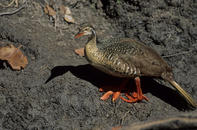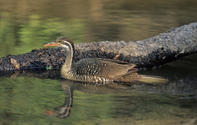Name
African Finfoot - Podica senegalensis
African Finfoot Appearance
The African Finfoot can be mistaken for a cormorant from a distance, but the bright orange legs, feet and bill make this bird easily distinguishable.
These birds do vary slightly in colour from region to region, but are typically brown above and whitish and brown mottled below.
A long thin neck with a small head, defined by a thin white stripe that runs from behind the eye and down the side of the neck. The African finfoot has lobed toes.
African Finfoot Diet
The African Finfoot feeds on insects, crabs, snails, molluscs and frogs.
African Finfoot Breeding
The African finfoot is monogamous and builds an untidy bowl-shaped nest out of sticks and reeds, on a branch, normally overhanging the water. Two eggs are laid and incubated solely by the female. The chicks leave the nest a couple of days after hatching.
African Finfoot Behaviour
The African finfoot is an extremely elusive bird, which makes sighting and studying this bird very difficult. The African finfoot is a very secretive bird, normally found singly.
If disturbed, the finfoot readily takes to the water and “runs” across the surface while fluttering its wings.
Finfoots forage along the banks of a river or stream, from the water.
Threats
None at present, but habitat degradation and pollution are impacting on the numbers of this bird. The main threat is pesticides that are flushed into the waterways, which leads to the reduction of food sources.
African Finfoot Distribution and Habitat
The African finfoot is found in gently flowing streams with overhanging vegetation. This bird is found in the southern and coastal regions of KwaZulu Natal and the Eastern Cape, as well as Mpumalanga, Limpopo and the North West.
By Karl Svendsen

